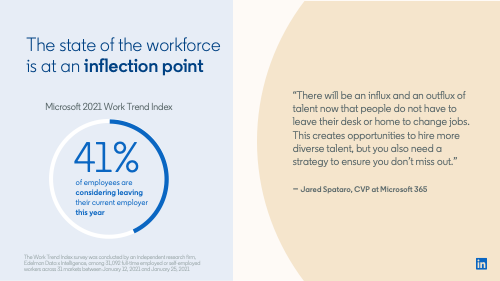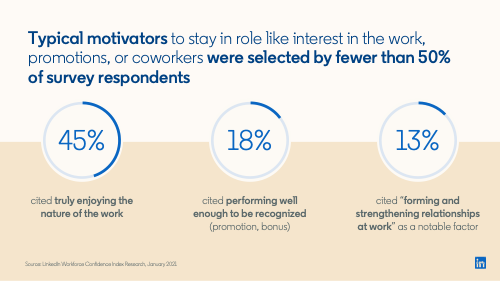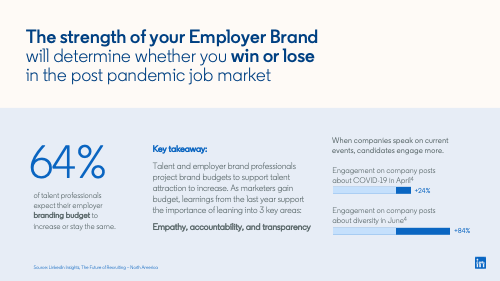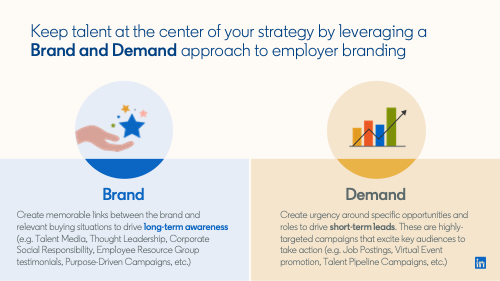Winning the War for Talent: Why Marketing and Your Employer Brand Are Key
Editor’s note: Morgan Lippitt and Lucas Bunzel contributed to the research in this post.
In a U.S. economy so profoundly disrupted by the COVID-19 pandemic, the general response to career decisions last year was to shelter-in-place. However, for many individuals this period of “business unusual” has altered career priorities, on-the-job motivation, and overall sense of what work means to us. With the increased vaccine availability and decreased number of U.S. cases, employee mobility (and attrition) is expected to accelerate. How can U.S. employers build a strong defense for the impending post-pandemic talent wars? And what role will the marketing department play?
The Microsoft 2021 Work Trend Index reveals that 41% of employees are considering leaving their current employer this year, with 46% planning to make a major pivot or career transition. For companies just beginning to recover, this level of attrition could mean a drastic loss of productivity from vacant roles and high costs of hiring. A “war” for talent occurs when the number of vacated or new roles outweighs the number of active job seekers (forcing employers to compete with other brands for new hires). This post will outline why one of the strongest defenses to attract future talent is to invest in your brand’s equity today.
In order to contextualize Microsoft’s findings on job seeker outlook, we cross-referenced it with LinkedIn’s Workforce Confidence Index* (which surveys about 5,000 U.S.-based members) to uncover the talent migration trends in store for 2021. Here’s what we found:
- Attrition spikes were "postponed” this year, shaped by a “shelter-in-job" mindset. Our historical hiring data shows that across industries and roles, attrition is seasonal. There are two annual spikes in job posting activity: March and August-October. However, amid 2020’s mass layoffs and economic uncertainty, the past year’s seasonal attrition was significantly lower. According to the LinkedIn Workforce Confidence Index, when job-holders were asked about their top motivations for staying in their current roles, 74% chose answers that amounted to some variant of “shelter in job.”
- Typical motivators to stay in a role — such as interest in the work, promotions, or peer relationships —were significantly lower in 2021. The LinkedIn Workforce Index reported a stark decline in employee motivation at the beginning of 2021. In the survey of 5,520 LinkedIn members from Jan 16 to Jan 29, 2021, just 45% cited truly enjoying the nature of their work. And only 18% cited performing well enough to be recognized (via a promotion, bonus, etc). Most strikingly, only 13% of our survey respondents chose “forming and strengthening relationships at work” as a notable factor in deciding to stay in their current role. The existence (or absence) of work friends has historically been a key factor in how people feel about their jobs. Pandemic-related safeguards have transformed work into a much more isolated experience— thus, social connections may have lost their power.
- Vaccine distribution is accelerating, and dormant industries will open back up. This fall’s seasonal attrition cycle will align with widespread vaccine distribution in the U.S. This timing could amplify (and even double) the number of individuals seeking their next career move. LinkedIn data shows that national hiring was 158.4% higher in May 2021 compared to May 2020 (the low point of hiring during the pandemic), with notable shifts in Recreation & Travel, Entertainment, and Retail industries. Even full-time employees are looking for better jobs right now. According to a recent edition of LinkedIn’s Workforce Confidence survey, which polled 5,076 LinkedIn members from April 24 through May 7, 48% of active seekers who already hold full-time jobs now feel more confident about their income increasing, (up from 36% in the second half of March 2021). Employees who felt unable to consider their options amid 2020’s economic uncertainty are becoming more risk-tolerant. As LinkedIn Senior Editor at Large George Anders was quoted in the Microsoft Work Trend Index, “We nearly have a doubling of job switching-intent. People are going to try and compress into one year what they might ordinarily have done in two.”
So, what does this mean for your company?
The world’s largest talent migration is on the horizon. There are many ways to fill vacated and newly created roles and reduce cost-per-hire, but one of the most powerful is to increase your brand’s equity.
The career trajectory of today’s job seeker can be hard to predict. It’s difficult to pinpoint precisely when the candidate journey begins, and which touchpoints are most influential in attracting talent to your company. But it’s safe to say that candidates are engaging with your brand months before clicking “apply.”
Those interactions could include being exposed to Sponsored Content, Job impressions, or Work With Us ads, following Your Company Page, receiving an InMail, visiting your website Career Page, among others. To compete in the impending war for talent a few months from now, your company must reach future jobseekers today. The strength of your employer brand has the power to influence the number of applications you receive, your InMail response rate, your offer acceptance rate and ultimately time-to-fill.
CMOs and CHROs must be in lock step to win the battle for talent.
The worlds of marketing and talent acquisition have never been more intertwined. Brand equity has always been a familiar — and profoundly influential — factor for marketers who promote products. Strong brand equity allows you to be able to charge more, experience lower acquisition costs, and enjoy better fiscal health. But brand equity holds the same power in career decisions; marketing to candidates is no different from marketing to consumers. Candidates are significantly more likely to respond to employers they know of, lowering the cost of talent acquisition.
And every seasoned marketer knows that a deep understanding of your target audience is critical to shaping your go-to-market strategy. Today’s value propositions for job seekers have largely changed, and brand awareness alone is not enough. In a 2021 survey from the Morning Consult, when given a choice between ‘enjoying their job’ and ‘working for a well-known company’, employed Americans overwhelmingly prioritize enjoying their job (79%). And 67% of people say that having a sense of purpose in their job is more important now than it was before the pandemic.
What exactly does ‘enjoying their job’ entail? Current job seekers told us they prioritize flexibility above all else. 50% of LinkedIn’s April Workforce Confidence survey respondents said that flexibility of hours or location has become more important to them, post-COVID, when it comes to looking for a new job opportunity. That’s the fastest-rising factor, ahead of work-life balance (45%), benefits such as health coverage (41%), pay (36%) and workforce culture (36%).
Another recent priority that has skyrocketed in importance is social justice. Today’s job seekers are looking for more purpose-driven employers that align with their personal values (equity, diversity, sustainability and transparency, among others). When companies speak out on current events, candidates engage more. LinkedIn platform data backs this up — engagement on company posts about diversity in June were 84% higher than engagement on other posts.
Soon after in July, LinkedIn Data Scientist Maeve Ryan wrote, “As many companies pledge their support for #BlackLivesMatter, they’re also being challenged to take further action on racial inequity, especially in regards to hiring a more diverse workforce. It’s a powerful reminder that employer branding is equal parts messaging and action. Messaging without action rings hollow, and action without messaging can go unnoticed.”
Candidates (and current talent, for that matter) are paying close attention to how companies respond to the major global movements taking place. They’ll remember which employers took a stance. To reduce attrition and attract new talent, modern employers must showcase their actions to rise up against social injustice, offer flexibility, and invest in their employees’ health and wellbeing during the pandemic. The role of the CHRO has seemingly never been more important, as the strategic leader putting these programs and responses in place. But it will take partnering with the CMO to fully communicate their employer brand as accountable, empathetic, flexible and transparent.
Your employer branding strategy requires both Brand and Demand effort.
At LinkedIn, we believe a winning talent attraction strategy leverages both brand (broadly-targeted campaigns that create a memorable link between your employer brand and a hiring situation in the future) and demand generation (narrowly-targeted campaigns that generate interest in a more immediate offering).
Brand campaigns help to increase your share of voice, a critical metric in an overly-crowded hiring market. Your brand equity impacts your company’s awareness (making your organization known and familiar to your desired talent pool); mindshare (earning time and attention from an increasingly discerning audience); and competitiveness (ability to differentiate from similar employers).
Examples of employer brand campaigns for talent could include interviews with DE&I leaders at your company, employee testimonials about how the company has invested in their wellbeing, showcasing recent initiatives from employee resource groups, moonshot initiatives, or sustainability commitments. This kind of thought leadership amplifies your company culture and should be showcased on your LinkedIn Career Page or through Talent Media.
Demand efforts, on the other hand, are intended to generate immediate talent leads and fill open roles. This is where precise targeting capabilities are paramount. You can diversify your talent pipeline by targeting nontraditional backgrounds or remote geo-locations, and make open roles known to all prospective candidates who meet the required skills. LinkedIn ads can also capture relevant information for you as you nurture prospects along the journey. Whether you’re automatically engaging in back-and-forth dialogue with candidates through Conversation Ads, or capturing their information through Lead Gen Forms, these demand generation tools can help seamlessly build your talent pipeline.
Equally important is what you do organically on the LinkedIn platform (posting, engaging, hosting Live events, creating groups, etc.) to keep your company top-of-mind and reach new audiences. When members are on LinkedIn, they’re learning about a new topic, catching up on news, or getting updates on their colleague’s latest achievements. Your employer brand can show up as an organic and valuable part of their experience.
To win the war for talent, you need long-term strategies that focus on your target audience and modernize your employer brand.
The candidate journey to hire is longer than ever before and requires increasing numbers of digital touchpoints with an employer. The strongest talent acquisition strategies leverage always-on brand campaigns as well as intermittent lead generation campaigns at peak moments of the hiring process. To stand out in a crowded market, those campaigns must be job-seeker centric and keep talent front of mind. All messaging must be highly tailored to your desired audience, and distributed through the most compelling channels to reach them. Brand awareness alone is no longer enough to attract new hires; today’s jobseekers are looking for companies that meaningfully invest in their employees’ wellbeing, put programs in place that allow for flexibility, and take stances that authentically align with their values
The next phase of your company’s growth will be driven by your people. So what role do you want to play in the upcoming war for talent?
*In LinkedIn’s Workforce Confidence Index, members are randomly sampled and must be opted into research to participate. Students, stay-at-home partners and retirees are excluded from analysis so we can get an accurate representation of those currently active in the workforce. We analyze data in aggregate and will always respect member privacy. The results represent the world as seen through the lens of LinkedIn’s membership; variances between LinkedIn’s membership & overall market population are not accounted for.
To learn more about post-pandemic workforce trends, employer branding, and the evolving role of marketers, register for our Live With Marketers event on June 22nd from 11-12pm PST.
Related articles








